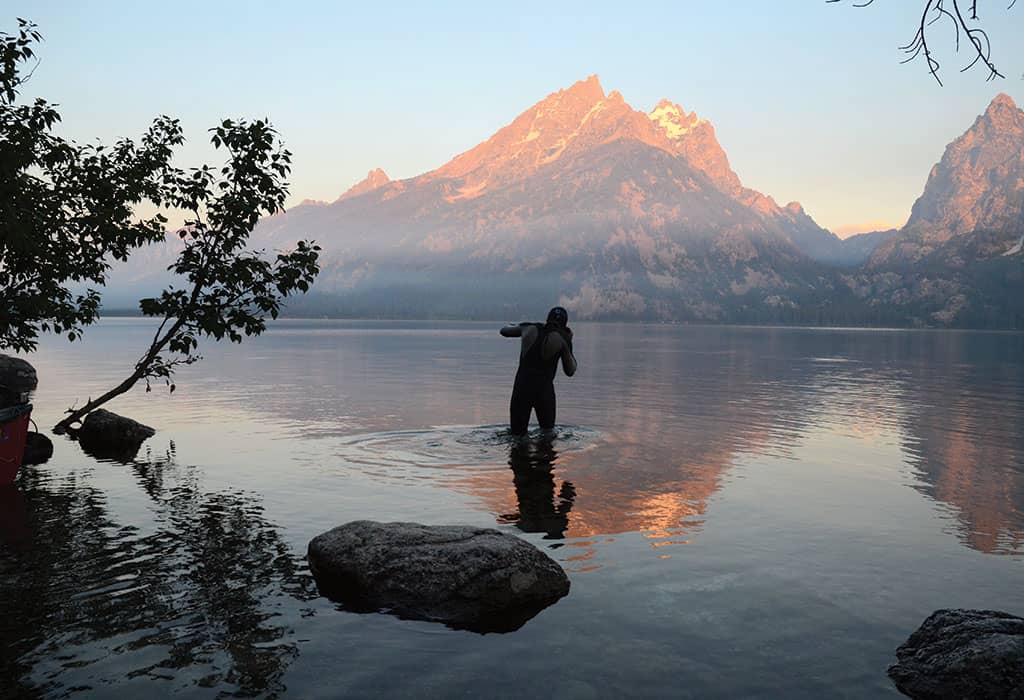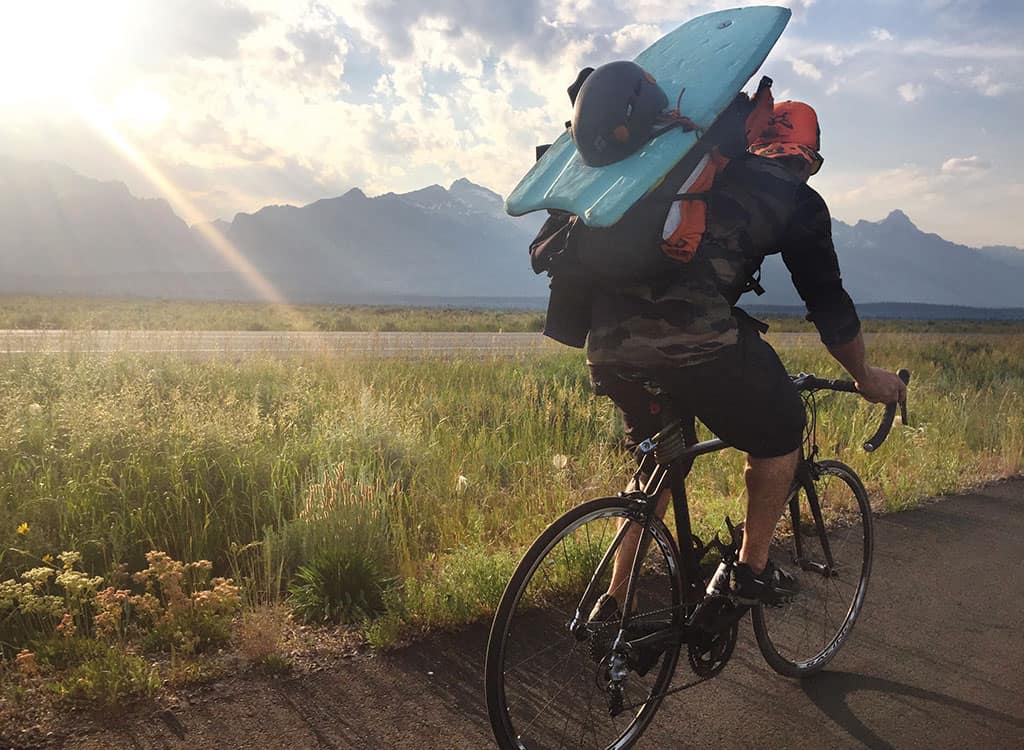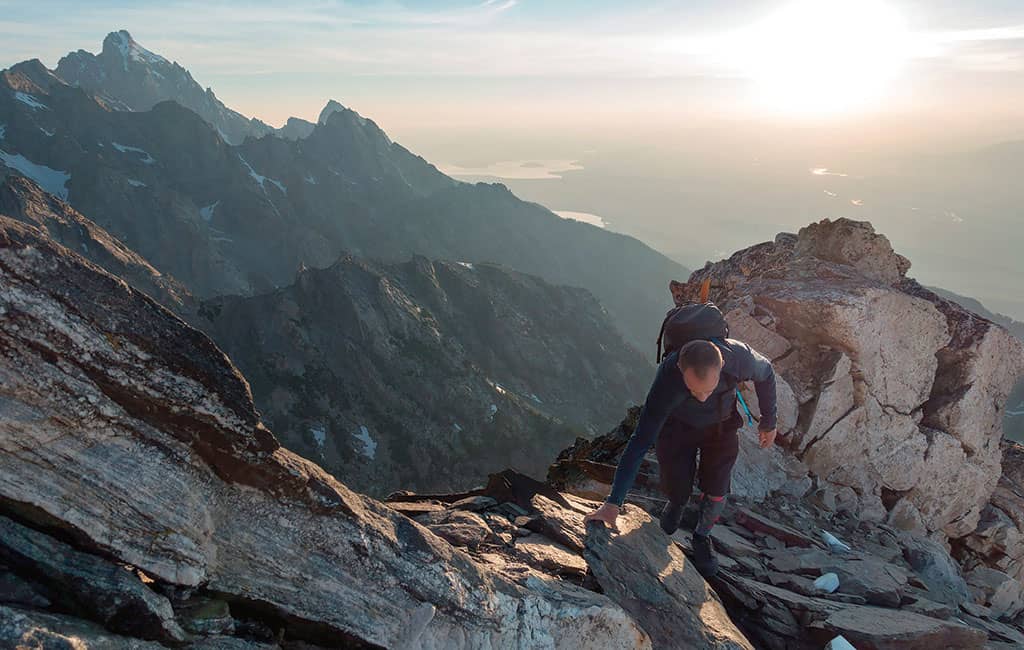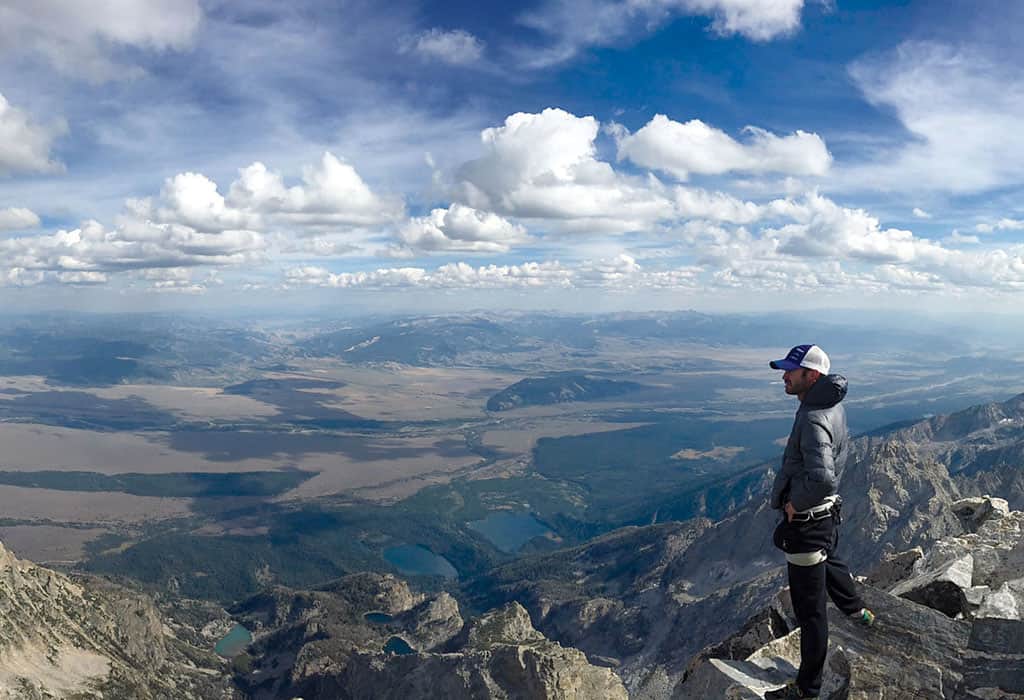Read The
Current Issue
Mountain Madness
In Jackson Hole, a ‘Picnic’ involves 67 miles of biking, swimming, hiking, and climbing. A bike ride Around the Block is 109 miles.
By Brigid Mander

ONE SUMMER DAY in 2011 Jackson resident David Gonzales set out from the Town Square on his road bike. Nothing unusual there. But it was 2:30 a.m., and Gonzales had more than cycling penciled into his day. The then-forty-four-year-old writer and mountaineer planned to ride 21 miles to Jenny Lake in Grand Teton National Park. There he’d put on a wetsuit and swim 1.2 miles across Jenny Lake. Across the lake, he would dry off, change into climbing clothes, and hop on the trail to the 13,775-foot summit of the Grand Teton. Gonzales biked and swam without incident. He hiked to the Lower Saddle, which sits at 11,600 feet. There, only 2,000 feet below the summit of the Grand, he saw bad weather coming in and turned around.

In summer 2012 Gonzales tried again. He biked, swam, and summited the Grand. Then he got a ride home. Gonzales himself is a mountaineer, which is a requirement of completing this endeavor. (Climbing the Grand Teton requires technical climbing skills and has several spots where you must be comfortable with the fact that a 2,000-plus-foot fall is only one misstep away). He’s friends with many other mountaineers. Telling one of them about his adventure, the friend pointed out that Gonzales left it unfinished: Mountaineers always return to the start of their route. Several weeks later Gonzales set out to do the round-trip. Twenty-three hours after he left it, he arrived back at the Town Square more elated than exhausted.

The round-trip totals nearly 70 miles. Gonzales did the whole thing solo, but did have a friend in a kayak paddling beside him as he swam across Jenny Lake. He named the endurance challenge “the Picnic,” because, “It was just a fun, challenging day in the mountains with some really good food for fuel.” Gonzales isn’t exaggerating when he says “good food.” It wasn’t energy bars or synthetic gels he brought, but chicken thighs, bacon, and sandwiches—proper picnic fare.
Some people might call the Picnic masochism. A sufferfest. Insanity. It is, perhaps, all three. But it’s also something else, Gonzales says: “You get up in the middle of the night and ride up into the Tetons under the stars, it’s wonderful! You get to a pristine lake; it’s the perfect length for a swim. Then you get out and go up into this jungle gym in the sky—and then you get to turn around and go back again.” It turns out that plenty of Jacksonites agreed with Gonzales, which led to lots of calls and emails asking for Picnic details.
Extreme fitness is the norm in Jackson Hole. Hike up Snow King and someone will tell you about the hike to the top of the tram at Jackson Hole Mountain Resort. Hike up to the top of the tram and then you’ll hear about Teewinot, a peak in Grand Teton National Park that includes over 5,000 feet of vertical ascent.
Do Teewinot and, as you’re celebrating afterwards with a beer or margarita at Dornan’s, you’ll hear about former Exum guides Rolando Garibotti and Alex Lowe, both of whom ran up Teewinot in under an hour (and then went on to climb nine other mountains in the same day). And then you’ll hear one bartender talking to another bartender about how his third time on the summit of Everest was really his last. Jackson’s Taco Bell and Daylight Donuts have both gone out of business, but stores selling outdoor gear thrive.
Gonzales, while an accomplished mountaineer, knew being the best or fastest wasn’t within reach. For that matter, being the best or fastest weren’t ever his goals. “I’m not a great athlete—I’m a pretty normal guy having fun testing limits,” he says. Since he’d been in the valley for upwards of fifteen years, by 2011 he had climbed the Tetons’ major peaks (sometimes a couple at once), had done all of the local road rides, and had run many of the valley’s trails. But he hadn’t ever combined them. The idea of a mountain triathlon was born. “I just wanted to see if I could do it,” he says.
Despite his personal enthusiasm and Jackson’s idea of fitness, Gonzales was caught off guard by how interested people were in the Picnic, which is alternately called the Grand Teton Triathlon. No one had ever done anything like it before, but it was clearly an adventure tailor-made for Jackson Hole’s extreme athletes. (A side note: One of the hallmarks of Jackson’s brand of fitness is that locals don’t see it as extreme.)
Since 2012 Gonzales has created more Picnics in the Tetons, and further afield in Montana and the Pacific Northwest. His aim is to keep competition and commercialism out of it, but he doesn’t mind company. He does it for the challenge, of course, but, ultimately, it is about having fun outside with friends and testing his limits. “It’s the opposite of an official event,” Gonzales says. “It’s about doing it yourself or with your friends. It’s self-recognition, because who else cares, really, and whatever you define it as, it’s your own picnic.”

THE EVOLUTION OF athletics into more challenging events is certainly not unique to Jackson Hole. Running races spawned triathlons, which are swim-bike-run events. The first one was held in 1974, in California. Today millions of people annually do triathlons, and it’s an Olympic event. There are numerous varieties of off-road triathlons (all less extreme than the Picnic). In Hawaii in 1978 fifteen men lined up for the very first Ironman, in which they were challenged to swim 2.4 miles, bike 112 miles, and, finally, run a full marathon of 26.2 miles. In 2016 there are 180 Ironman events scheduled in twenty countries around the world.
Marathons became ultramarathons, requiring runners to do fifty or one hundred miles. Want to spread your running out? The Marathon des Sables is a six-day, 156-mile race. Because running the equivalent of six marathons in six days isn’t enough, this race is across the Sahara Desert. According to Ultrarunning magazine, in 2014 there were more than 1,200 ultrarunning races, triple the amount held in 2004. Most recently, cross-country running courses have taken to adding obstacles. Four million people finished one of these races—Spartans, Tough Mudders, and Warrior Dash—in the United States in 2013, according to Running USA, a track and field advocacy group that has begun tracking these nontraditional running events. That same year only half a million people ran a marathon in the U.S.
There are races like the Leadville 100, in Colorado. You’d think the fact that the race starts at 10,151 feet would be challenging enough. But the “100” is in its name for a reason: The race, for both mountain bikers and runners, is one hundred miles. Even more incomprehensible is the Badwater Ultra, a foot race that begins 280 feet below sea level in Death Valley, California, and ends at 8,300 feet on Mt. Whitney. Over the course’s 135 miles, runners ascend 14,600 feet. This race gains in popularity every year.

IN HINDSIGHT IT shouldn’t be a surprise Jacksonites called Gonzales for info on the Picnic, but that it took so long for something like it to happen. After all, area climbers have been doing traverses linking up the main peaks of the Tetons for years. Both Exum Mountain Guides and Jackson Hole Mountain Guides even offer guided trips of the Cathedral Traverse (Teewinot, Mount Owen, and the Grand) and the Grand Traverse (Teewinot, Mt. Owen, the Grand, Middle, and South Tetons, Ice Cream Cone, Gilkey Tower, Spalding Peak, Cloudveil, and Nez Perce). They are usually done over two to four days, but in August 2000 Garibotti, previously mentioned for his speedy ascent of Teewinot, did the Grand Traverse in 6 hours and 49 minutes. His record still stands, and climbers and mountain runners still talk about it with awe.
Jackson cyclists have Around the Block: a 109-mile ride passing through Jackson; Victor and Swan Valley in Idaho; Alpine; and Hoback Junction. Whether you decide to go clockwise (ride up Teton Pass at the end) or counterclockwise (start the ride with the 2,100-foot climb up Teton Pass), know that’s not the only difficult part. There’s also Pine Creek Pass, between Victor and Swan Valley, and, along Palisades Reservoir, more rolling hills than you can count. “When I moved here, it wasn’t something I thought I would do,” says local photographer and cyclist John Slaughter. “But it’s great, and now I have done it multiple times.”
Many cyclists doing this ride are training for LoToJa—the longest single-day, annual bike race in the country that just happens to end in Teton Village. It starts 206 miles away in Logan, Utah.
When it’s time to graduate from Around the Block, there’s Around the Rock—a 154-mile ride that circles most of the Teton Range. (The “rock” is the range.) While Around the Block is all on paved roads, the Rock ride includes 30-some miles of dirt. Road and mountain biker Jill Damman rode Around the Rock “because my coach had me scheduled for a nine-plus-hour ride and what better way than riding around the Tetons?” she says. The day prior to Around the Rock, Damman, who won the women’s division of LoToJa in 2010, rode in a 45-mile mountain bike race near Sun Valley, Idaho. “I drove home and woke up the next morning and rode Around the Rock.” Damman does admit, “Considering I was coming off a huge block of training and racing, I was pretty destroyed after completing it.”
For skiers Jackson Hole Mountain Resort (JHMR) is consistently ranked as having the most challenging terrain of any ski resort in North America. But locals still wanted more. The Jackson Hole Air Force (JHAF) is an under-the-radar fraternity of skiers who, in the 1980s and 1990s, ducked ski-area boundary lines to get to even more extreme terrain than the resort’s lifts accessed. In 1999 JHMR made accessing the terrain the JHAF had been illegally skiing for decades legal. It was among the first ski resorts in the country to allow skiers to access neighboring backcountry terrain from its lifts.
Join a local as he/she walks the dog or is in need of some exercise before heading to work on a winter day and chances are you’ll find yourself at the top of Teton Pass. Skis (or a snowboard) will be strapped to the outside of a pack on your back. Inside the pack will be avalanche gear. In front of you will be a 1,700-foot climb to the summit of Mount Glory. When you leave the parking lot, it will be dark. The sun rises as you hike. “Originally, as an outsider to dawn patrols and someone who loves to sleep in, the concept sounded ludicrous, but a friend convinced me to try it,” says Danny Béasse, an architect at Carney Logan Burke who gets up at 5:30 a.m. on dawn patrol mornings so he can be in the office at 8. “There is something special about being in the mountains at a time when everyone else is asleep. Nothing beats summiting a mountain at sunrise and skiing fresh powder back down to the car, all before work. It rejuvenates me and is usually a highlight of my week. I got some weird looks the first time I mentioned it to coworkers, so now I only tell the ones who understand. Otherwise I keep it as my own little secret since it feels like I cheated—like I snuck something into my day that no one else did except for the close friends I skied with.”
It is impossible to keep an accurate count of the number of skiers dawn patrolling—yes, it is a verb, too—on Teton Pass, but many mornings, even when there is no fresh snow, the parking lot at the top is full by 7 a.m. (The lot has room for approximately sixty cars.)

Hiking 1,700 feet up Glory in the dark is child’s play compared to Béasse’s winter weekend adventures, which may include what he calls the “Teton Hat-Trick.” Béasse, who moved to Jackson in 2001 and describes his pre-Jackson fitness level as “above average,” connected all three local ski resorts, Grand Targhee, JHMR, and Snow King, in a day. He had a friend drop him at Grand Targhee early in the morning, and he skinned up the front side of that resort before it opened. From the top of Targhee, he skied east across the Tetons to the backside of JHMR and then skied up the backside of that resort. “I missed a waffle by thirty minutes,” he jokes, talking about the fresh waffles served until 2 p.m. daily at Corbet’s Cabin at the top of the tram. Béasse skied down to the base of JHMR, where he had previously stashed a bicycle, which he then rode to the base of Snow King Mountain in downtown Jackson. He ended his Hat-Trick by skinning up and then skiing down Snow King. He was skiing for 10.5 hours.
Runner and climber Ryan Burke, who is a full-time addictions therapist at Curran-Seeley Foundation, moved to Jackson Hole from Maine ten years ago. His first time climbing the Grand, the round-trip took 21 hours and was a struggle. These days a round-trip from the Lupine Meadows parking lot to the top of Wyoming’s second-highest peak takes Burke about 3.5 hours. He has finished the Picnic in 11 hours, 28 minutes. Not that Burke cares, but as far as anyone knows, this is the fastest time for it. In summer 2015 he summited twenty-two Teton peaks in four days. Burke named this the “Perception Traverse.”
“There’s a domino effect in this town: You start climbing Snow King, then the Middle [Teton], then the Grand. You start bumping into people you thought were superhuman, from the pages of Outside magazine, in the bar or on Snow King. You realize they are just people, and seeing what they do on a daily basis, you start thinking, ‘Why can’t I do that?’ It just opens your perspective of what people can do, and it becomes normalized.”
When Burke wanted a greater challenge than Around the Rock, he invented Around the Clock: swim the 6-ish mile perimeter of Jenny Lake, run 42 miles on the Valley and Teton Crest trails (including going up and down four passes) to the top of Teton Pass, and then ride 109 miles Around the Block, finishing back at the top of Teton Pass. Burke did this in 2014. Including two flat tires near the end of the bike ride, and, because his bike pump broke—resulting in him having to go and get his mountain bike to ride the final 15 miles—the whole thing took 30 hours. “I was exhausted at the end, probably the most tired I had ever been,” Burke says as nonchalantly as if he were talking about a 10k run. “There were several high and low points.”
Burke cites the simple thrill of finding new challenges. “There’s a ‘What’s next?’ attitude in this town. It can be dangerous, but it can be progressive. You have to be careful with these things—that you are not doing them for other people. You do them so you can feel good at the end of the day.”





